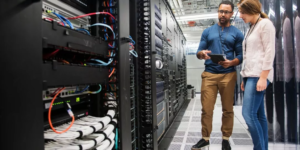Intellyx BrainBlog for IBM by Jason Bloomberg
This is part four in a five-part series on mainframe modernization.
The secret to mainstreaming the mainframe into today’s modern, cloud-centric IT environments is to make the experience of working with the mainframe like the experience of working off the mainframe—especially the developer experience (DX).
Historically, working on the mainframe was an entirely different experience from the distributed world. Mainframes sported green-screen terminals (or terminal emulators), mainframe-specific tools and programming languages, and entirely different ways of organizing and accessing data, managing security, and leveraging any operating system-level functionality.
Giving developers a modern DX on the mainframe requires more than a new skin, however. Developers require hands-on interaction with the tools they use—a deep relationship that makes the technology their own, even as they work in the cloud.
The key to this deep relationship? Open-source software.
DevOps, open source and the mainframe
Open-source software and DevOps share a common philosophy and technical underpinnings. Understanding one is essential to understanding the other.
DevOps is a mindset, a culture and a set of technical practices that foster better communication and collaboration across the software lifecycle. Tools-based automation is an important enabler, but DevOps is more a change in human perception and behavior than a technological effort.
The DevOps team in many organizations works with the developers and operations people to assemble and manage the various automation technologies that support the continuous integration and continuous deployment (CI/CD) parts of the lifecycle—what we’ve come to call the DevOps toolchain.
GitOps is also an important enabler of CI/CD and, by extension, DevOps. GitOps is a cloud-native model for operations that takes into account model-driven, configuration-based deployments onto immutable infrastructure that support dynamic production environments at scale.
GitOps gets its name from Git, the hugely popular, open-source code-management tool. Adopting standard tools and processes like Git and GitOps can empower an organization’s development practices to more effectively deliver on business outcomes.
Empowering teams to use a standard pipeline based on Git to orchestrate the development and deployment of an application unleashes productivity.
Since mainframe developers should be on the same team as everyone else, they should have an active role in the development lifecycle. As a result, the optimal architecture for achieving mainframe inclusiveness balances activities on the mainframe with its integration into the broader DevOps toolchain.
Such an architecture includes many open-source elements. One source of such software is the Open Mainframe Project (OMP), hosted by the Linux Foundation and championed by IBM, Broadcom, Rocket Software and others.
The flagship project at the OMP is Zowe. The goal of Zowe is to equip mainframe developers with all the tools they need to be first-class DevOps participants—both during the development process where continuous intengration (CI) applies and when deploying software into production the continuous deployment (CD) way.
The OMP based Zowe on IBM z/OS, IBM’s operating system for its Z mainframes. Zowe is a software framework that includes a core set of applications, APIs and operating system capabilities to support future development.
Zowe offers developers modern interfaces to interact with z/OS, enabling them to work with the mainframe as they do in modern cloud environments. Third-party vendors are also welcome to create plug-ins and extensions to include Zowe capabilities in commercial development tools. IBM is also championing the open-source-based Wazi. Wazi is a family of tools for delivering a cloud-native DX for z/OS and providing for cloud-native development and testing for z/OS in the IBM Cloud. With Wazi, developers can quickly spin up a z/OS dev and test system or create their own custom image from on-premises mainframe LPARs (logical partitions).
Read the entire BrainBlog here.



